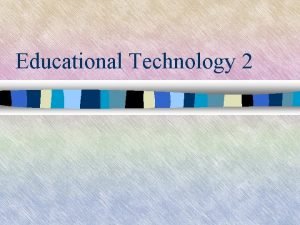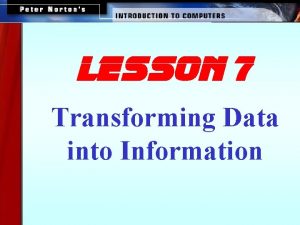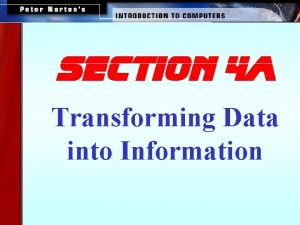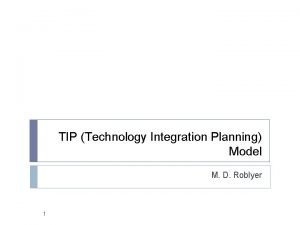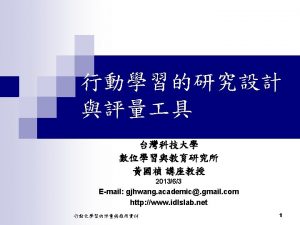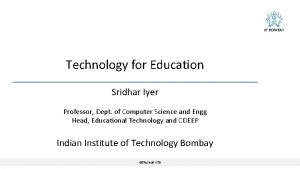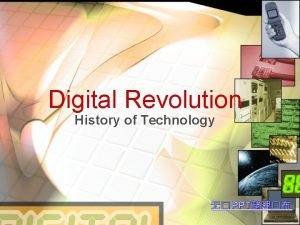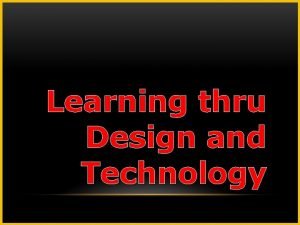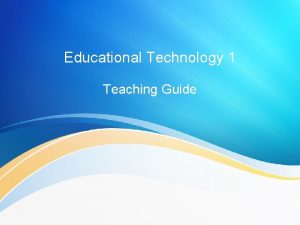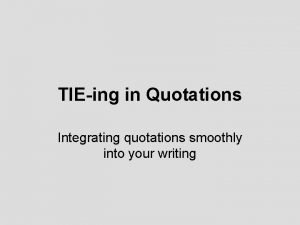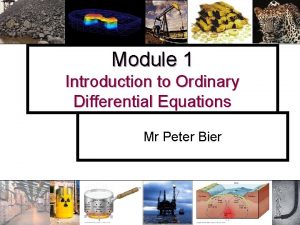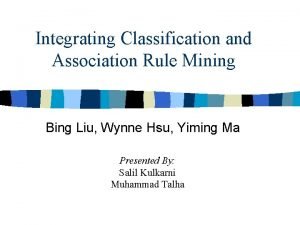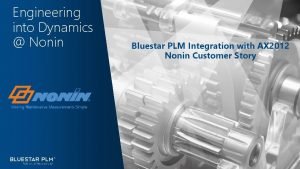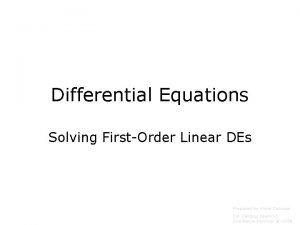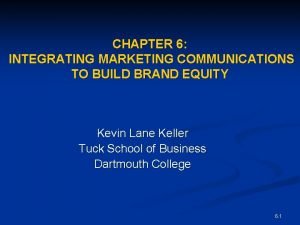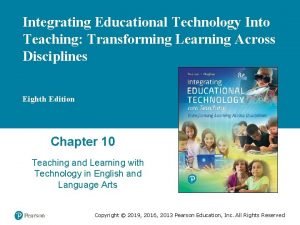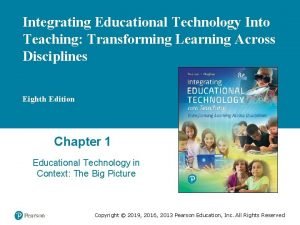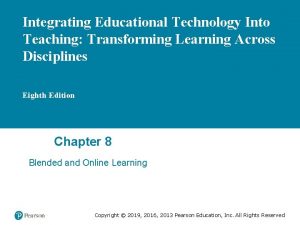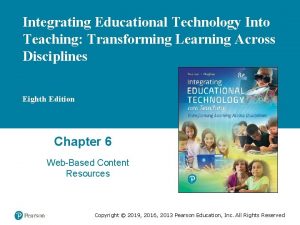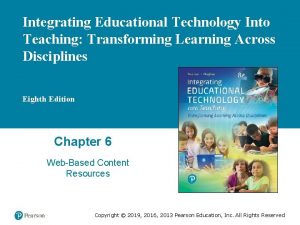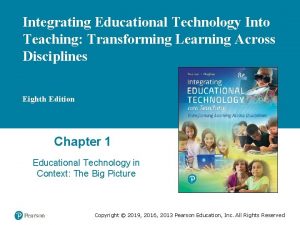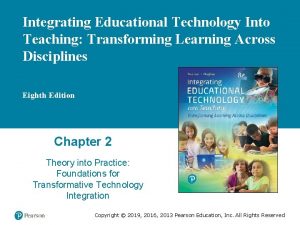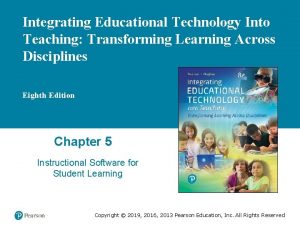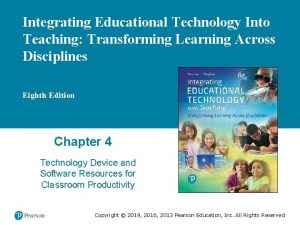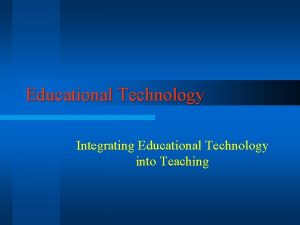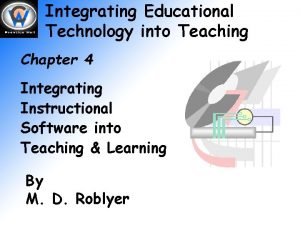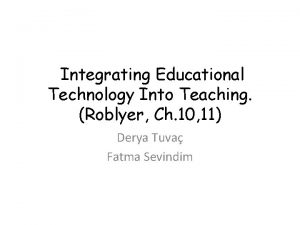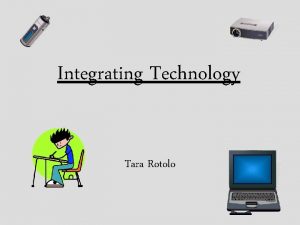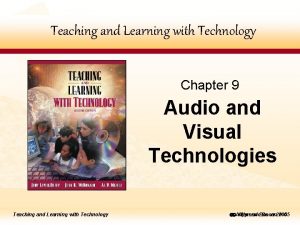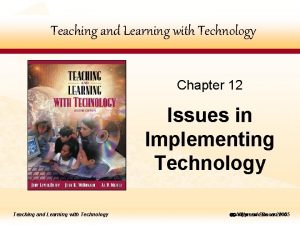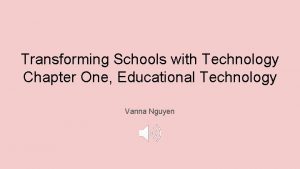Integrating Educational Technology Into Teaching Transforming Learning Across























- Slides: 23

Integrating Educational Technology Into Teaching: Transforming Learning Across Disciplines Eighth Edition Chapter 3 Learning and Leading for Transformative Technology Integration Copyright © 2019, 2016, 2013 Pearson Education, Inc. All Rights Reserved

Learning Objectives (1 of 2) 3. 1 Identify the mindsets of teacher leaders that contribute to their ability to identify problems and create solutions. (ISTE Standards for Educators: 1—Learner; 2 —Leader; 4—Collaborator) 3. 2 Describe connected educators, connected learning communities, and the technological resources that support teacher engagement in connected learning activities. (ISTE Standards for Educators: 1—Learner; 2 —Leader; 3—Citizen; 4—Collaborator) Copyright © 2019, 2016, 2013 Pearson Education, Inc. All Rights Reserved

Learning Objectives (2 of 2) 3. 3 Recognize strategies to build a compelling and consistent online professional identity. (ISTE Standards for Educators: 1—Learner; 2—Leader; 3—Citizen; 4— Collaborator) 3. 4 Generate a personal rationale for using technology in teaching based on history, educational standards, contextual conditions, emergent trends, learning theory, and research findings. (ISTE Standards for Educators: 1 —Learner; 2—Leader) Copyright © 2019, 2016, 2013 Pearson Education, Inc. All Rights Reserved

Technology Integration in Action: Teacher Leadership Makes It! • Phase 1: Analysis of Learning and Teaching Assets and Needs – Step 1: Analyze problems of practice (POPs) – Step 2: Assess technological resources – Step 3: Identify technological possibilities • Phase 2: Design of the Integration Framework – Step 4: Decide on learning objectives and assessments – Step 5: Design integration strategies and determine relative advantage – Step 6: Prepare instructional environment and implement the lesson • Phase 3: Post-Instruction Analysis and Revisions – Step 7: Analyze lesson results and impact – Step 8: Make revisions based on results – Step 9: Share lessons, revisions, and outcomes with other peer teachers Copyright © 2019, 2016, 2013 Pearson Education, Inc. All Rights Reserved

Teacher Leadership Copyright © 2019, 2016, 2013 Pearson Education, Inc. All Rights Reserved

Definition of Teacher Leadership • Teacher leaders are K-12 teachers who lead in and outside their classroom • Teacher leaders: – Pursue important educational challenges identified by teachers – Pursue activities that challenge status quo, uphold fair and equitable educational opportunities, and act for and on children’s behalf • Teacher leadership is enabled by: – Creativity – Agency – Community Copyright © 2019, 2016, 2013 Pearson Education, Inc. All Rights Reserved

Benefits and Challenges of Being a Teacher Leader • Benefits – Better working relationships with colleagues – Confidence and empowerment – Growth as professional – Engaging in more leadership work • Challenges – Increased stress to balance teacher and leader roles – Lack of time – More tasks – Power issues with colleagues – Resistant colleagues Copyright © 2019, 2016, 2013 Pearson Education, Inc. All Rights Reserved

The Connected Educator Copyright © 2019, 2016, 2013 Pearson Education, Inc. All Rights Reserved

Definition of Connected Educators • Connected educators – Teachers who engage in connected learning – Teachers act as agents involved in their own learning • Connected learning – Learning with others online to advance their professional knowledge Copyright © 2019, 2016, 2013 Pearson Education, Inc. All Rights Reserved

Connected Learning Communities • Conferences and meetings – Edcamps – Meetups • Professional learning communities (PLCs) – Often school-based and face-to-face • Personal learning network (PLN) – Designed by the educator – Pursue self-identified professional learning, growth, and sharing • Communities of practice (COP) – Special interest groups – An example of a distributed knowledge network Copyright © 2019, 2016, 2013 Pearson Education, Inc. All Rights Reserved

Technological Resources for Connected Learning • Technologies for – Socially connecting – Collaborating – Documenting information – Curating information – Archiving information – Creating information Copyright © 2019, 2016, 2013 Pearson Education, Inc. All Rights Reserved

Strategies for Developing as a Connected Educator • Invest time in your professional network • Schedule time for and time-off from networking • Promote other people • Respond to connected people in your network • Assume and offer trust • Build relationships • Model connected learning Copyright © 2019, 2016, 2013 Pearson Education, Inc. All Rights Reserved

Benefits of Being Connected Educators • Motivation to learn and engage in the teaching profession • Access to different perspectives and inspiration • Autonomy and agency for learning • Increased innovation, status, and reputation • Feedback on ideas • Engagement with other educators • Flexible scheduling of learning • Meaningful relationships, knowledge, attitudes, and values Copyright © 2019, 2016, 2013 Pearson Education, Inc. All Rights Reserved

Challenges of Being Connected Educators • Reliance on Internet access • Little time to engage in more work Copyright © 2019, 2016, 2013 Pearson Education, Inc. All Rights Reserved

Online Teacher Identity Copyright © 2019, 2016, 2013 Pearson Education, Inc. All Rights Reserved

Digital Footprint • The information that exists online about a person based on their online activities • Footprint begins immediately when users use online social media resources • Teachers’ digital footprint is held to higher standards • Teachers need to develop, manage, and maintain a positive online reputation Copyright © 2019, 2016, 2013 Pearson Education, Inc. All Rights Reserved

School Policies for Online Activity • Examine school/district policies – Acceptable use policy (AUP) – Website and intranet policy – Social media policy • Guidelines for teachers’ online activity – Understand data privacy – Model good digital citizenship everyday for students – Consult policies regarding student-teacher online connections Copyright © 2019, 2016, 2013 Pearson Education, Inc. All Rights Reserved

Building a Professional Online Identity (Teacher Brand) • Step 1: Determine your strengths • Step 2: Choose a focal digital platform • Step 3: Build consistent, professional, digital presence • Step 4: Expand your presence using social networking • Step 5: Publicize your expertise • Step 6: Engage with others Copyright © 2019, 2016, 2013 Pearson Education, Inc. All Rights Reserved

A Personal Rationale for Educational Technology Copyright © 2019, 2016, 2013 Pearson Education, Inc. All Rights Reserved

Building a Personal Ed. Tech Rationale (1 of 2) • A continuous professional process that: – Reflects teacher’s beliefs about educational technology – Influences the technology possibilities chosen to solve educational problems – Convinces others to support technology-based instruction – Answers the question: “Why should the teacher or students use technology? ” Copyright © 2019, 2016, 2013 Pearson Education, Inc. All Rights Reserved

Building a Personal Ed. Tech Rationale (2 of 2) • Consider the following influences on educational technology integration – History of educational technology (Chapter 1) – Educational standards for digital literacy and subject areas (Chapter 1) – Contextual conditions influencing integration (Chapter 1) – Recent trends in emerging technologies (Chapter 1) – Epistemologies of directed instruction and constructivist learning theory (Chapter 2) – Educational technology research findings (all chapters) Copyright © 2019, 2016, 2013 Pearson Education, Inc. All Rights Reserved

A Technology-Use Rationale Based on Transformation • How does technology motivate and engage students? • How does technology support students’ learning needs? • How does technology prepare students for the future? Copyright © 2019, 2016, 2013 Pearson Education, Inc. All Rights Reserved

Copyright © 2019, 2016, 2013 Pearson Education, Inc. All Rights Reserved
 Middle level integration
Middle level integration How to insert a quote
How to insert a quote Paragraph writing
Paragraph writing Teaching across age levels
Teaching across age levels The unit that transform data into information
The unit that transform data into information Transforming data into information in computer
Transforming data into information in computer Troy aegean sea
Troy aegean sea Cuadro comparativo e-learning y b-learning
Cuadro comparativo e-learning y b-learning Tip model educational technology
Tip model educational technology Educational technology & society
Educational technology & society Educational technology interoperability
Educational technology interoperability Sridhar iyer iit bombay
Sridhar iyer iit bombay Historical development of educational technology ppt
Historical development of educational technology ppt Logia meaning in technology
Logia meaning in technology Principles of educational technology
Principles of educational technology Meaning of educational technology
Meaning of educational technology Meaning of microteaching
Meaning of microteaching Embedded quotes mla examples
Embedded quotes mla examples Lateral ventricle anatomy
Lateral ventricle anatomy Integrating factor method
Integrating factor method Integrating classification and association rule mining
Integrating classification and association rule mining Bluestar plm dynamics
Bluestar plm dynamics Intergrating factor
Intergrating factor Integrating marketing communication to build brand equity
Integrating marketing communication to build brand equity
